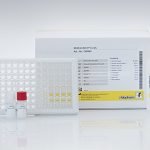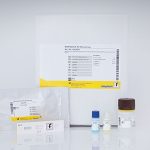Intended use:
The RIDA® CCD-Inhibitor is an accessory for use in in vitro diagnostics for the inhibition of anti-CCD IgE in human serum and plasma.
General information:
CCDs (cross-reactive carbohydrate determinants) are carbohydrate side chains inducing the production of specific IgE antibodies. A Type I allergy is caused by the formation of specific IgE antibodies against allergens. Most allergens are proteins. In eucaryotic organisms, many proteins are subjected to post-translational glycosylation and therefore carry carbohydrate side chains. Specific IgE antibodies are produced by the immune system against the real allergens but also against carbohydrate side chains of allergens (anti-CCD IgE) of plant origin, of insects, of molluscs and of latex. The anti-CCD IgE also leads to cross-reactions with unrelated proteins and therefore are called “cross-reactive carbohydrate determinants (CCD)”.
CCDs do not cause allergic symptoms
Approximately 25 % of allergic patients produce anti-CCD IgEs, which, however, do not trigger allergic symptoms and therefore most likely have no clinical relevance. This low clinical significance was thought to be due to low binding affinity of anti-CCD IgE and/or poor biologic activity of these antibodies. Low binding affinity could be excluded by experiments from Jin et al.1 where binding affinities of anti-CCD IgE and IgG were determined and turned out to be quite high. It was also shown that anti-CCD IgG exhibited a stronger binding affinity than IgG directed against peptides. As the anti-CCD IgE titers in the sera of most patients were low it was assumed that IgG against-CCDs in allergic patients may act as blocking antibodies by competing with IgE for CCDs and hence prevent the binding of the IgE antibodies to CCDs and the development of clinical symptoms.
Specific IgE against CCDs are detected by in vitro assays and lead to “false” positive results. It was suggested that the detection of anti-CCD IgE in RAST-tests is due to monovalent binding of IgE to parts of the glycan epitopes which in vivo would not be sufficient to activate mast cells or basophiles and lead to clinical symptoms. As these cross-reactions produce positive results in in vitro laboratory test systems, they must be considered false positive. These false positive results lead frequently to discrepancies between skin prick test results and laboratory test results. In order to correctly distinguish between true positive and false positive results, anti-CCD IgE antibodies should be inhibited to prevent binding to the CCDs in in vitro test.
Indication for the use of RIDA® CCD-Inhibitor
Occurrence of positive reactions to a high number of allergens for a specific sample in the in vitro test system but also discrepancies between skin prick test and serological test results are indicative of false positive reactions caused by anti-CCD IgE antibodies. In these cases it is recommended to treat the serum with the RIDA® CCD-Inhibitor and to repeat the test.
Alternative Diagnostics:
Functional Allergy Testing with R-Biopharm’s Histamine-Release-Test HR-Test is an ex vivo method to detect allergen induced histamine release from basophil leukocytes of the patient.
Description of the RIDA® CCD-Inhibitor
Glycopeptides containing a maximum of four amino acid residues are purified from the plant glycoprotein bromelain and coupled to human serum albumin. This ensures absence of protein-based IgE epitopes and hence maximum specificity.
| Art. No. | ZA0601 |
|---|---|
| Test format | 5x RIDA® CCD-Inhibitor (lyophilised) |
| Sample preparation | Dissolve the lyophilisate with 55 μl bidest. H2O. In order to dissolve the lyophilisate first remove the test tube from the refrigerator and allow it to warm up to room temperature (RT) for approx. 30 minutes. Then add 55 μl H2O and thoroughly vortex for 30 seconds. Then centrifuge it briefly to ensure that no liquid remains in the cap. Pipet 10 μl of the dissolved RIDA® CCD-Inhibitor into 400 μl of serum or plasma, shake, and incubate for one hour at RT while shaking. The treated serum or plasma must be tested immediately after incubation. |
| Incubation time | 60 min |
Dear customers,
we have started to provide the documents for our products in an electronic format. These are the Instructions for Use (IFU), the Safety Data Sheets (SDS) and the Certificate of Analysis (CoA). For batches placed on the market after 01 January 2023, you can find our documents on the eIFU portal eifu.r-biopharm.com/clinic.










